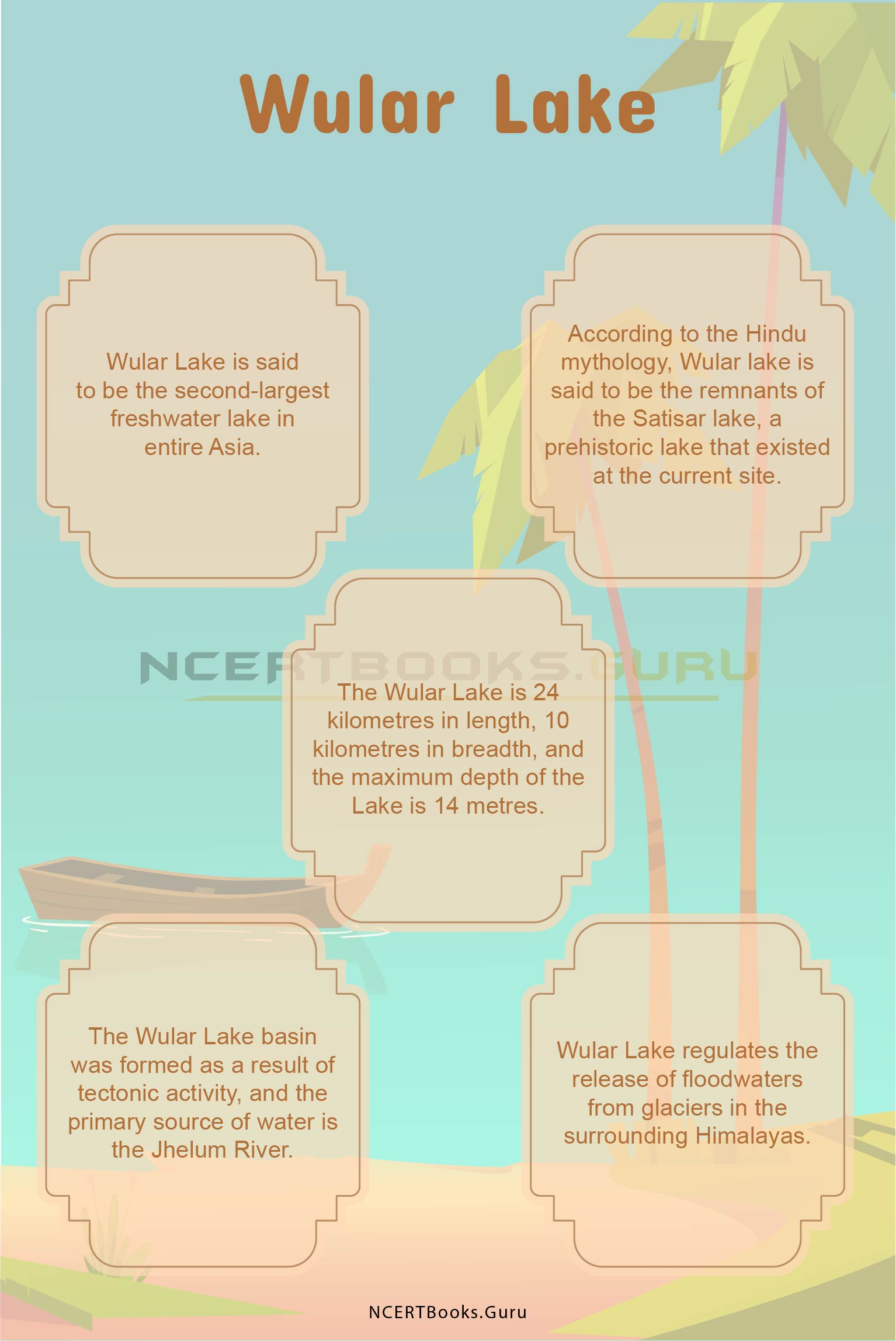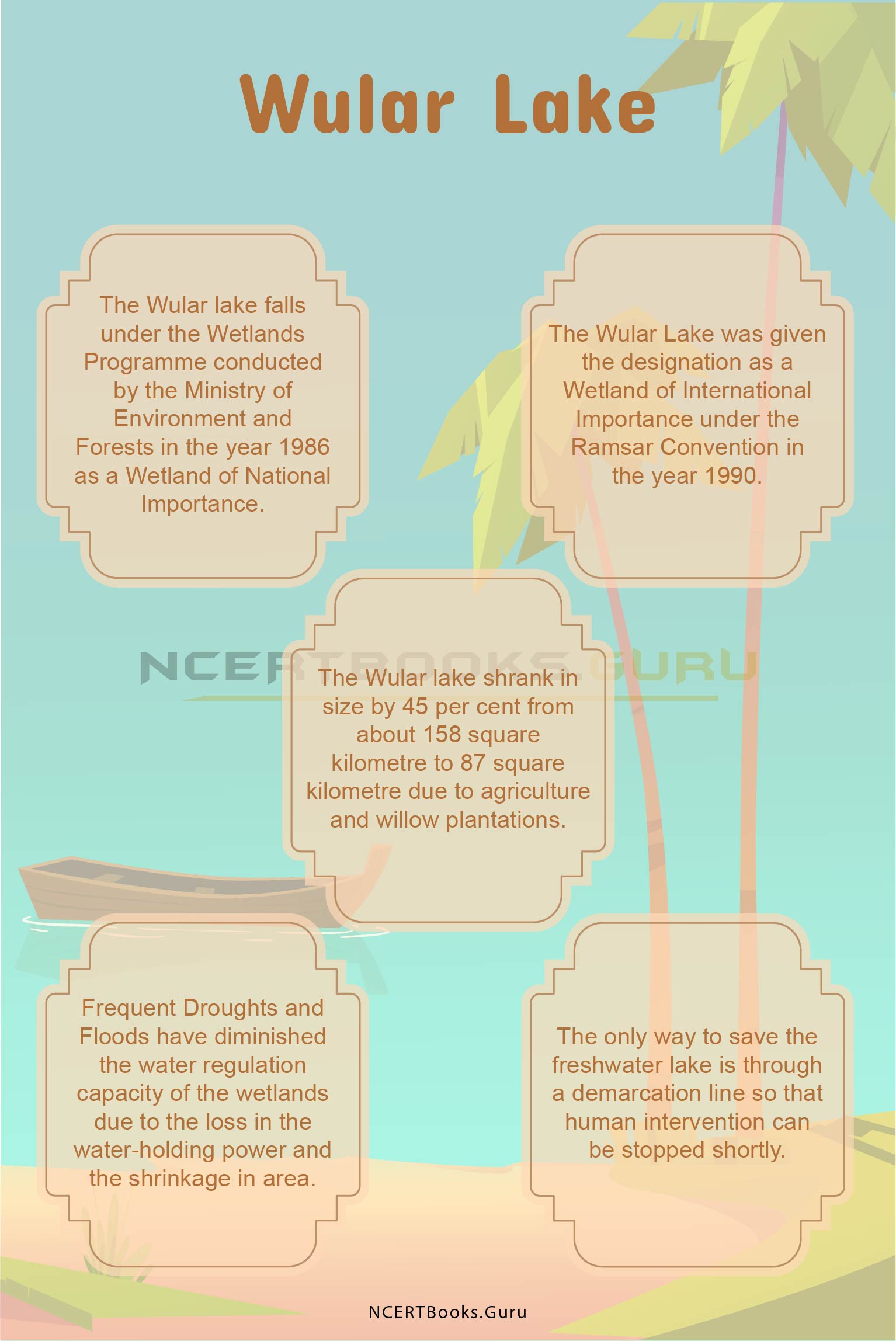Wular Lake is one of the largest freshwater lakes in India and the entire subcontinent, situated in the district of Bandipora in Jammu and Kashmir, India. The Wular Lake basin is a result that was formed due to tectonic activity, and the source of water is the Jhelum River. The current scenario of Wular Lake is drained due to the consequence of willow plantations, initially built on the shore during the 1950s.
Wular Lake Details
| Name of the River | Wular Lake |
| Primary Source of Inflow | Jhelum River |
| Location | Bandipora District, Jammu and Kashmir |
| Length | 24 kilometres |
| Breadth | 10 kilometres |
| Importance |
|
| Pollution | Encroachments, rampant plantation of willows, and siltation |
About Wular Lake
Wular Lake is the second-largest freshwater lake in the whole of Asia that is located in a small District of Bandipora in Jammu and Kashmir. The size of the Wular lake differs seasonally from twelve to 100 square miles or 30 to 260 square kilometres.
Wular Lake basin is a formation due to the active tectonic activities and the primary source of water that feeds the Lake is the River Jhelum. It is situated at the foothills of Harmukh Mountain. Wular Lake lies between the towns Bandippore and Sopur in Sangrama, near Baramulla Road.
Wular Lake is said to be a remnant of Satisar Lake, a lake of the ancient times and the premises of this lake was a famous sunset point. At the entrance of the Wular Lake, a project known as the Tulbul Project was constructed to keep the navigation in a lock-cum-control structure.
However, the largest freshwater lake has considerably shrunk over the eight decades and records state that about 27 square metres of the lake has silted up and has turned into a landmass.
Wular Lake History
Wular Lake is the second-largest freshwater lake in the entire subcontinent, and it is the major tributary of the Indus basin. Wular lake plays a vital role in regulating the release of the floodwaters produced due to the glaciers in the surrounding region of the Himalayas.
According to Hindu mythology, Wular lake is said to be the remnants of the Satisar lake, a prehistoric lake that existed at the current site.
During the 1980s, the Central Government of India proposed to construct the Wular barrage to dam water inflow; however, the project was shelved after the rise of militancy in the state.
The Wular Lake is commonly associated with the wetlands as it is an essential habitat for multiple migratory waterbirds within the Central Asian Flyway and also supports a rich biodiversity.
Due to its hydrological, biological, and socio-economic values, the Wular lake falls under the council as a Wetland of National Importance for its intensive conservation and management purposes under the Wetlands Programme of the Ministry of Environment and Forests, Government of India in the year 1986.
In the year 1990, the Wular lake was given the designation as the Wetland of International Importance which falls under the Ramsar Convention.
Wular Lake has played a vital role in supporting biodiversity and livelihoods for decades. Due to the widespread reclamation and drainage of the lake and its marshes for agriculture, settlements and plantations the lake produces hundreds of tons of silt every year.
The rivers Erin, Bohner, and Madamati, arising and channelling its way from the mountain ranges and the rivers Vetasta and the Ningal from the south are the root cause of the uprising silting problem experienced at the site of the Wular Lake.
Wular Lake Map
Wular Lake is one of the largest freshwater lakes in the whole of the Asian subcontinent and is situated at the Bandipora district, Jammu and Kashmir. It is located 50 kilometres away from the central Srinagar city in Northwest India. The Wular Lake basin is a structure that was formed based on the results of tectonic activities, and the primary source of water that feeds the lake is the Jhelum River.
The Wular Lake is 24 kilometres in length, 10 kilometres in breadth, and the maximum depth of the Lake is 14 metres. The overall size of the Wular Lake is 189 square. Kilometre and lies at an altitude of 1,580 metres.
The Wular Lake controls the channel of the flow of the Jhelum River, which traverses it. At the South-West of the shore, a town of Sopur is present, and to the Northeast, exists an island.
Wular Lake System
Wular Lake, the largest lake in the Jammu and Kashmir territory and the entire subcontinent is present in the northern part of the Indian subcontinent. The Lake is located in the Indian-held sector of the environment and is 10 miles or 16 kilometres long and 6 miles or 10 kilometres wide.
Wular Lake lies at the North end of the Vale of Kashmir, which is about 20 miles or 32 km North to Northwest of the Srinagar city. The area of the Wular Lake varies from 12 to 100 square miles or 30 to 260 square kilometre according to the season.
Have a look at the List of Important Lakes in India that you need to know for your competitive exams to score well.
Wular Lake Pollution
The second-largest Asian lake has met its end due to the high levels of silting, encroachment, massive plantation, and extension of agriculture fields. These activities have contributed to the shrinkage of the Wular Lake area and degradation of the natural resources.
During the period between 1911 to 2008, due to the overall water spread and marsh areas, the Lake shrunk by over half, reducing almost one-fifth of the area’s water storage capacity. The levels of the ever-increasing populations, encroachments around the Wular Lake has led to the killing of its aesthetic beauty.
Another significant contributor to Wular Lake’s pollution and shrinkage is the plantation of about two million willow trees. The willow trees were the primary source of wood for several insects such as crickets, bats, source of fruits, and the primary contributor of fires.
Additionally, the frequent hits of drought and flood have diminished the water regulation capacity of the wetland leading to a loss in water-holding power and shrinkage of the Wular Lake.
The only way to save the freshwater lake is through a demarcation line so that human intervention can be stopped shortly.
Wular Lake Importance
Wular Lake fosters an essential role in the hydrographic system plan for the Kashmir valley as it helps in the absorption of the basin for annual floodwater.
The lake and its extensive surrounding marshes have a vital flora and fauna collection. The Wular Lake is a sustainable wintering destination for several migratory waterfowl species such as Shoveler, Little Egret, Mallard, Cattle Egret, and the common Pochard.
The Lake houses exotic species of birds that are enlisted under the RED List of the IUCN such as Pallas’s Fish-eagle and Marbled Tea. However, multiple terrestrial species of birds are observed to be dwelling around the Wular Lake such as Himalayan Pied Woodpecker, Short-toed Eagle, Monal Pheasant, Little Cuckoo, and the European Hoopoe.
Another important fact about the Wular Lake is the habitat for fishes and contributes about 60 per cent of the fish yield in the region of Kashmir valley.
The most governing species of fishes that are found to survive in Wular Lake are multiple species of Schizothorax, Gambusia affinis, Cyprinus carpio, Crossocheilus latius, Barbus conchonius, and species of Nemacheilus. These thriving availability of the species of fishes help more than 8000 fishermen earn their livelihood.

Short Essay on Wular Lake
Wular Lake, the second-largest freshwater lake in Asia, is situated between the towns of Bandipora and Sopore. Wular Lake covers an area of about 125 square kilometres and is the livelihood source of thousands of anglers.
Wular Lake is a natural flood reservoir and water security for Jhelum River as it drains off the excess water. The natural beauty of Wular Lake is its location, situated amidst the snow-clad hills.
Wular Lake is the primary habitat for the exotic avian and Pisces life of the region. The freshwater lake provides about 60 per cent of the fish yield of the Kashmir region and around eight thousand to ten thousand fishers earn their livelihood from this region and supply adequate quantities of fish in the whole state.
The Wular wetlands generate a source of revenue for the State Government through fisheries and sales of fodder, chestnut, and other economically important species. The catchment area of the lake supports various indigenous species such as the alpine pastures and the coniferous forests.
Wular Lake is rich in its biodiversity and socio-economic values and houses multiple exotic and terrestrial birds like sparrow hawk, eared kite, Himalayan pied woodpecker, short-toed eagle, alpine swift, and many more.
Due to its rich biodiversity, Wular Lake was designated as a Wetland of International Importance under the Ramsar Convention in the year 1990. Wular Lake remains as the ideal for a romantic time near the turbulent and shimmering waters.
10 Lines on Wular Lake
- Wular Lake is said to be the second-largest freshwater lake in entire Asia
- According to the Hindu mythology, Wular lake is said to be the remnants of the Satisar lake, a prehistoric lake that existed at the current site
- The Wular Lake is 24 kilometres in length, 10 kilometres in breadth, and the maximum depth of the Lake is 14 metres
- The Wular Lake basin was formed as a result of tectonic activity, and the primary source of water is the Jhelum River
- Wular Lake regulates the release of floodwaters from glaciers in the surrounding Himalayas
- The Wular lake falls under the Wetlands Programme conducted by the Ministry of Environment and Forests in the year 1986 as a Wetland of National Importance
- The Wular Lake was given the designation as a Wetland of International Importance under the Ramsar Convention in the year 1990
- The Wular lake shrank in size by 45 per cent from about 158 square kilometre to 87 square kilometre due to agriculture and willow plantations
- Frequent Droughts and Floods have diminished the water regulation capacity of the wetlands due to the loss in the water-holding power and the shrinkage in area
- The only way to save the freshwater lake is through a demarcation line so that human intervention can be stopped shortly.

FAQs on Wular Lake
Question 1.
State the location of the Wular lake
Answer:
Wular Lake is one of the largest freshwater lakes in the whole of the Asian subcontinent and is situated in the District of Bandipora, Jammu and Kashmir.
Question 2.
State the dimensions of the Wular Lake.
Answer:
The Wular Lake is 24 kilometres in length, 10 kilometres in breadth, and has a maximum depth of the Lake is 14 metres.
Question 3.
Name a few essential exotic and terrestrial avian species found in the wetlands of Wular Lake.
Answer:
The Lake houses exotic species of birds such as Pallas’s Fish-eagle and Marbled Tea. The terrestrial species of birds observed to be dwelling around the Wular Lake are Himalayan Pied Woodpecker, Short-toed Eagle, Monal Pheasant, Little Cuckoo, and the European Hoopoe.
Question 4.
How does the Wular Lake contribute to the revenue source for the State Government?
Answer:
The Wular wetlands generate a source of revenue for the State Government through fisheries and sales of fodder, chestnut, and other economically important species. The catchment area of the lake supports various indigenous species such as the alpine pastures and the coniferous forests.
